Youth gap
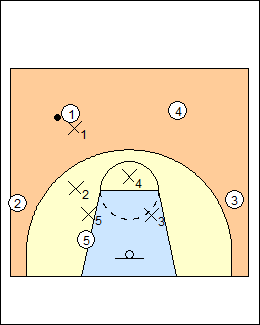 | 1 A simplified gap defence for youth basketball teams (e.g. U12): - play ballhandlers straight up (ball-you-basket) instead of shading or forcing sideline, middle or weak hand - shrink the floor by gapping one pass away on both sides of the ball - gap defenders help and recover on dribble penetration - run and jump switch on a baseline drive, a two-man rotation - defend a ballside low post on the high side - switch any screens. See Youth Basketball - Defence, Blog post - Youth Basketball Defence & Offence, Defence - Petitgoue Youth, and Forcing left pack for progressions. Here X1 is the on-ball defender, - X2 and X4 are gap defenders, the same distance from the ball and their check (isosceles triangles) - X3 is a help defender - X5 denies low post 5 on the line up the line. Gap and help defenders are ball-you-check, seeing both (pistols). All defenders communicate their position (ball, gap, help, deny). Use shell drills to build team defence, starting with 2-on-2 and 3-on-3 (see Shell breakdowns), then 4-on-4 (e.g. Woodley 4 on 4). |
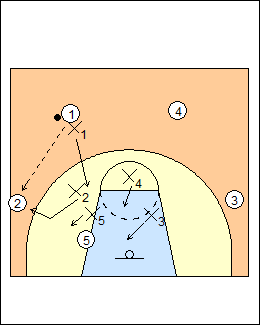 | 2 On a pass to 2, - X1 sprints to a gap position (jumps to the ball) - X2 closes out, does not get beat to the baseline side (it's not a straight closeout) - X4 and X3 are help defenders and sink, seeing ball and check - X5 denies 5 from the high side. As a rule of thumb, X3 and X4 are about the same distance from the ball and their check. See Defending - Boone 1 on 1 (2 on 1 closeout). For some drills to work on closeouts, see Closeout-slide-backpedal, Defending - Close-out lines, Jump to the ball. |
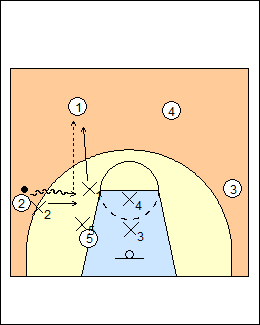 | 3 On a middle drive by 2, gap defender X1 helps and recovers (closes out). On a close-out, sprint then chop feet, take away a shot if in shooting range, but the primary concern in youth basketball is a blow-by, so contain the ball. SNYB - Offensive/Defensive Concepts (pdf) - defensive ready position - feet shoulder width apart, slightly staggered - weight on balls of both feet - bend ankles, knees, hips - head upright and looking forward, back fairly straight - arms extended out to the sides in position to intercept a pass - hands above elbows and below shoulders. Dan Becker - Defensive Stance - comfortable athletic stance, feet outside shoulder width, sit down, engage hips, weight on balls of feet, hands are out and busy. Dwane Casey - Defensive Stance - athletic stance, down and comfortable, close enough to touch, the left hand is a stick hand against a right-hand shooter (up to contest a shot), the right hand is a dig hand (digging up on the ball). See Defensive stance (Tara VanDerveer), Ball up ball down (Jr. NBA), 1 on 1 - Alba (jump straight back on a jab step, then recover), also Defending - Spurs shift & close. To work on guarding the ball (including defensive slides), see Defending - Nash wave, Duke form slides, Lane slides, Zig-zag halfcourt, Slide and run. |
 | 4 On a post entry pass, X5 jumps behind 5, gaps off, it's 1 on 1, play the ball straight up. |
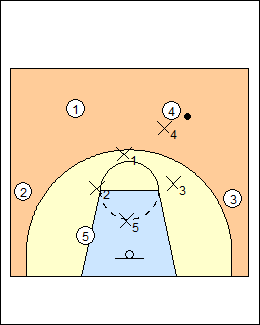 | 5 Here X4 is on the ball, X1 and X3 gap, X2 and X5 are in help positions. |
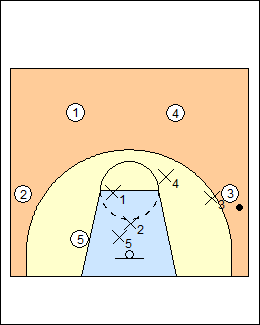 | 6 Here X3 has the ball, X4 gaps, X1, X2 and X5 are all in help positions. |
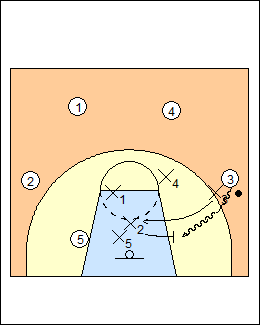 | 7 Baseline Penetration On a baseline drive, X3 drop steps and slides, then turns and runs if beaten, calls "help", help defender X2 helps and calls "switch", X3 runs through to take 2, a two-man run and jump switch (help and stay). Variation - X5 helps and stays, X3 takes 5. X5 can help late on dribble penetration, i.e. block a shot. For progressions see Defence - Forcing left pack, Defending - 4 on 4 help rotations (help the helper, double-team), Defence - Forcing left basics, Defending - Forcing-left shell (deny a pass to the right, early help off the low post). |
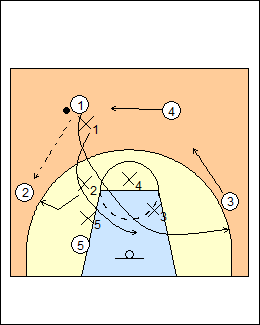 | 8 Jump to the ball By jumping to the ball on any perimeter pass, the on-ball defender is in position to help on dribble penetration and takes away a face cut if the passer cuts to the basket. See Defending - Face cuts, Jump to the ball, also Shell breakdowns. |
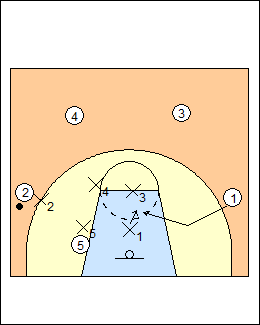 | 9 Smash a Flash A help defender sees ball and check (pistols), is ready to smash a flash from weakside, denying a pass into the paint area. See Defending - Villanova jump to the ball, Weakside cuts. See Blog post - Jump to the ball. |
 | 10 Ballscreens If 1 follows a pass to 4 and ballscreens, X1 and X4 switch it. See Defending - Messina ballscreens, 4 on 4 ballscreens, Blog post - Ballscreen coverage. |
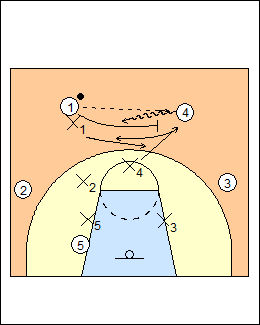 | 11 Progression - X1 leaves a gap that X4 uses to stay with 4. Variation - X1 stays close to 1 ("squeezes" the screen), X4 goes under both to stay with 4. For dribble hand-offs, see Defending - Woodley 4 on 4. |
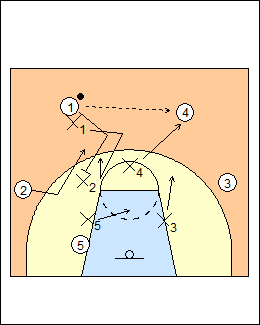 | 12 Off-Ball Screens Here 1 passes to 4 and screens for 2, X1 and X2 come together and switch, X1 takes cutter 2. Progression - X1 leaves a gap that X2 uses to stay with 2. Variation - X1 squeezes the screen, X2 goes under both. See Defence - Messina off-ball screens, Defending - Oakland downscreens (chase the cutter), Blog post - Defending off-ball screens.  |
This page was made with Basketball playbook from Jes-Soft